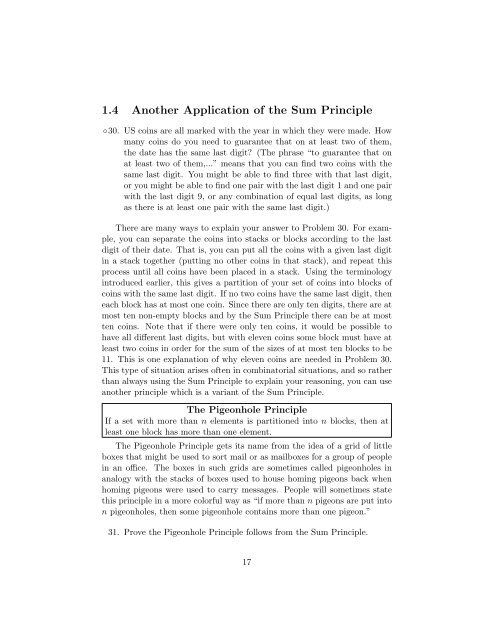DISCRETE MATHEMATICS THROUGH GUIDED DISCOVERY ...
DISCRETE MATHEMATICS THROUGH GUIDED DISCOVERY ...
DISCRETE MATHEMATICS THROUGH GUIDED DISCOVERY ...
You also want an ePaper? Increase the reach of your titles
YUMPU automatically turns print PDFs into web optimized ePapers that Google loves.
1.4 Another Application of the Sum Principle<br />
◦30. US coins are all marked with the year in which they were made. How<br />
many coins do you need to guarantee that on at least two of them,<br />
the date has the same last digit? (The phrase “to guarantee that on<br />
at least two of them,...” means that you can find two coins with the<br />
same last digit. You might be able to find three with that last digit,<br />
or you might be able to find one pair with the last digit 1 and one pair<br />
with the last digit 9, or any combination of equal last digits, as long<br />
as there is at least one pair with the same last digit.)<br />
There are many ways to explain your answer to Problem 30. For example,<br />
you can separate the coins into stacks or blocks according to the last<br />
digit of their date. That is, you can put all the coins with a given last digit<br />
in a stack together (putting no other coins in that stack), and repeat this<br />
process until all coins have been placed in a stack. Using the terminology<br />
introduced earlier, this gives a partition of your set of coins into blocks of<br />
coins with the same last digit. If no two coins have the same last digit, then<br />
each block has at most one coin. Since there are only ten digits, there are at<br />
most ten non-empty blocks and by the Sum Principle there can be at most<br />
ten coins. Note that if there were only ten coins, it would be possible to<br />
have all different last digits, but with eleven coins some block must have at<br />
least two coins in order for the sum of the sizes of at most ten blocks to be<br />
11. This is one explanation of why eleven coins are needed in Problem 30.<br />
This type of situation arises often in combinatorial situations, and so rather<br />
than always using the Sum Principle to explain your reasoning, you can use<br />
another principle which is a variant of the Sum Principle.<br />
The Pigeonhole Principle<br />
If a set with more than n elements is partitioned into n blocks, then at<br />
least one block has more than one element.<br />
The Pigeonhole Principle gets its name from the idea of a grid of little<br />
boxes that might be used to sort mail or as mailboxes for a group of people<br />
in an office. The boxes in such grids are sometimes called pigeonholes in<br />
analogy with the stacks of boxes used to house homing pigeons back when<br />
homing pigeons were used to carry messages. People will sometimes state<br />
this principle in a more colorful way as “if more than n pigeons are put into<br />
n pigeonholes, then some pigeonhole contains more than one pigeon.”<br />
31. Prove the Pigeonhole Principle follows from the Sum Principle.<br />
17

















